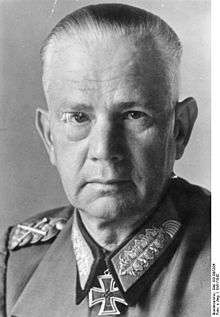Walther von Reichenau
| Walther von Reichenau | |
|---|---|
 Generalfeldmarschall Walther von Reichenau, 1941 | |
| Birth name | Walter Karl Ernst August von Reichenau |
| Born |
8 October 1884 Karlsruhe, German Empire |
| Died |
17 January 1942 (aged 57) Poltava, Ukrainian SSR, Soviet Union |
| Buried at | Invalidenfriedhof Berlin |
| Allegiance |
|
| Years of service | 1903–1942 |
| Rank | Generalfeldmarschall |
| Commands held |
10th Army 6th Army |
| Battles/wars |
World War II |
| Awards | Knight's Cross of the Iron Cross |
Walter Karl Ernst August von Reichenau (8 October 1884 – 17 January 1942) was a German officer and Generalfeldmarschall during World War II. While in command of the 6th Army (Wehrmacht) during Operation Barbarossa in 1941, he issued the notorious Severity Order which encouraged German soldiers to murder Jewish civilians on the Eastern Front, and he was in charge of forces which helped to commit the massacre of over 33,000 Jews at Babi Yar as well as other massacres during the Holocaust.
World War I
Born in 1884, Reichenau served in World War I and was awarded the Iron Cross 2nd and 1st Class. After the Armistice of 11 November 1918, he joined the Grenzschutz Ost Freikorps. In 1919 Reichenau was selected to remain in the newly established Reichswehr of the Weimar Republic. The officer corps of the new armed forces' was limited to 4,000, and there was to be no German General Staff. Reichenau took a post in the Truppenamt, which was the "underground" equivalent of the General Staff formed by Hans von Seeckt. From 1931 Reichenau was Chief of Staff to the Inspector of Signals at the Ministry of the Reichswehr, and later served with General Werner von Blomberg in East Prussia.
Nazi support
Reichenau's uncle was an ardent Nazi and introduced him to Adolf Hitler in April 1932. Reichenau joined the Nazi Party, although doing so was a violation of the army regulations laid down by Seeckt to insulate the army from national politics.[1]
When Hitler came to power in January 1933, Blomberg became Minister of War and Reichenau was appointed as head of the Ministerial Office, acting as liaison officer between the Army and the Nazi Party. He played a leading role in persuading Nazi leaders such as Göring and Himmler that the power of Ernst Röhm and the SA must be broken if the army was to support the Nazi-led government. This led directly to the "Night of the Long Knives" of 30 June 1934.
In 1935 Reichenau was promoted to lieutenant general (Generalleutnant) and was also appointed to command the military forces in Munich. In 1938, after the Blomberg-Fritsch Affair, in which General Werner von Fritsch was forced out of the Army command, Reichenau was Hitler's first choice to succeed him, but older leaders such as Gerd von Rundstedt and Ludwig Beck refused to serve under Reichenau, and Hitler backed down.
World War II
In September 1939, Reichenau commanded the 10th Army during the German invasion of Poland. In 1940 he led the 6th Army during the invasion of Belgium and France, and in 1940, Hitler promoted him to field marshal during the 1940 Field Marshal Ceremony.
Barbarossa

During the German invasion of the Soviet Union, as commander of the Sixth Army, he led his army into the heart of Russia during the summer of 1941. The Sixth Army was a part of Army Group South, and captured Kiev, Belgorod, Kharkov and Kursk. Reichenau supported the work of the SS Einsatzgruppen in exterminating the Jews in the occupied Soviet territories. During its offensive into the Soviet Union, the German army was confronted with a number of superior tank designs. Reichenau inspected the Soviet tanks he came across, entering each tank and measuring its armour plate. According to general staff officer Paul Jordan, after examining a T-34, Reichenau told his officers "If the Russians ever produce it on an assembly line we will have lost the war."[2]
Death
On 14 January 1942 Reichenau suffered a stroke after a run in cold weather.[3] He died before he could be evacuated to Germany. The flight carrying his body crashed while landing in Lemberg. Hitler gave him a state funeral.[4]
War Crimes
Politically, Reichenau was an anti-Semite who equated Jewry with Bolshevism and the perceived Asian threat to Europe. The infamous "Reichenau Order" or Severity Order of October 1941 supported the Nazi genocidal policies by instructing the officers thus:
In this eastern theatre, the soldier is not only a man fighting in accordance with the rules of the art of war... For this reason the soldier must learn fully to appreciate the necessity for the severe but just retribution that must be meted out to the subhuman species of Jewry....[5]
All Jews were henceforth to be treated as de facto partisans, and commanders were directed that they be either summarily shot or handed over to the Einsatzgruppen execution squads of the SS-Reichssicherhauptamt as the situation dictated.[5] Upon hearing of the Severity Order, Reichenau's superior Field Marshal Gerd von Rundstedt expressed "complete agreement" with it, and sent out a circular to all of the Army generals under his command urging them to send out their own versions of the Severity Order, which would impress upon the troops the need to exterminate Jews.[6]
Awards
Promotions
See alsoReferencesCitations
Bibliography
External links
| |||||||||